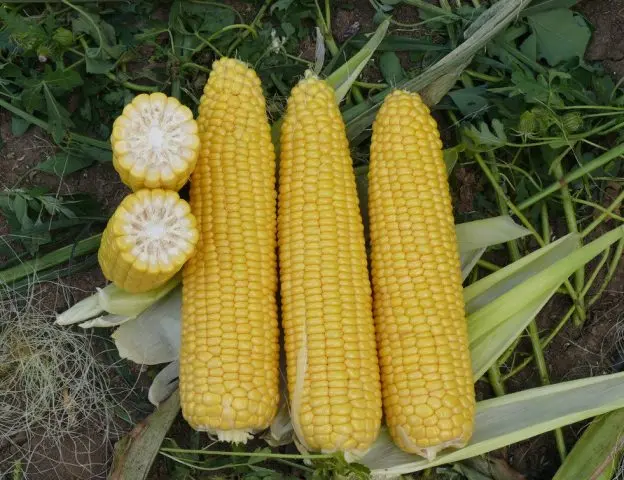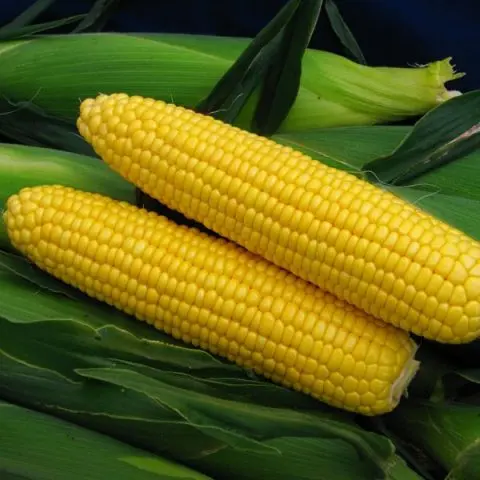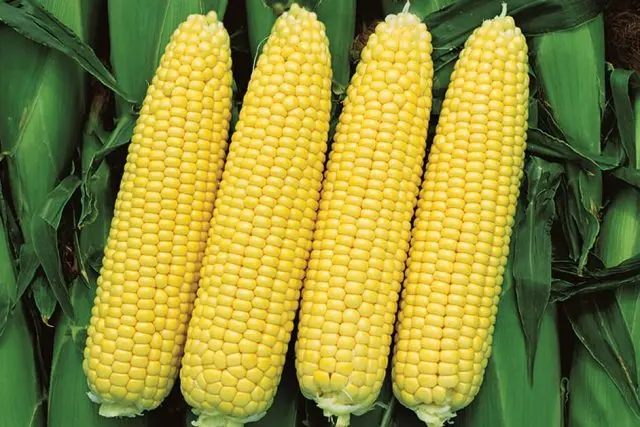Contents
Sweet corn has long been a popular cereal crop and is cultivated by humans for both fodder and table purposes. And this is not surprising, since corn is famous for its gastronomic qualities, as well as its high nutritional value, providing a person with a third of the necessary trace elements. In addition, it is not difficult to grow sweet corn: by planting seeds on a plot of land in spring, every gardener will be able to regale on extraordinarily tasty cobs in the middle of summer.

The difference between sweet corn and regular corn
Not everyone can distinguish sweet corn from ordinary, because the obvious differences are invisible to the inexperienced eye. However, there are still distinguishing features:
- in ordinary corn, the seeds are darker and larger;
- the cob of sweet corn is more often barrel-shaped with a blunt end;
- in sugar varieties, even in the raw form of grain with a pronounced sweet taste: it is the increased sugar content that is the main difference between sugar varieties and fodder varieties;
- Sweet corn kernels are much softer than regular corn.
Unlike regular corn, sweet corn must be harvested as soon as it enters the stage of milky maturity.
The best varieties of sweet corn
Breeders managed to get more than 500 types of crops, below are the best varieties of sweet corn.
Dobrinya

The variety belongs to early ripening and remains popular among gardeners, thanks to the friendly and fast germination of seeds, as well as unpretentiousness in care, resistance to fungal infections. Seeds can be sown in the soil as soon as the temperature at night does not fall below +10 °C. The plant reaches a height of 1,7 m, the length of the ears is about 25 cm. The taste of the grains is very delicate, milky and sweet. After 2 – 2,5 months after sowing, the crop is ready for harvesting. Dobrynya corn is suitable for both boiling and canning.
Spirit

An early ripe, productive variety that grows to a height of 1,9 – 2 m and has a cob length of 19 – 22 cm, with a weight of approximately 200 – 350 g. The grains have a rather high concentration of sugar in the composition – more than 12%. Seedlings are planted in open ground in May, and after 65 days the heads of cabbage reach full maturity. The variety is resistant to diseases and pests. And thanks to good adaptation to any conditions and consistently high yields, the cultivation of sweet corn Spirit fits into the main business.
Ice nectar

This variety belongs to the late-ripening ones: at least 130 days must pass from the moment of sowing until the cob fully ripens. In height, the stems of the plant stretch up to 1,8 m, the length of the cobs is 25 cm, they contain juicy, large grains. Ice nectar is distinguished by its characteristic white grain color and the highest sugar content of all sweet corn varieties. Therefore, the hybrid belongs to dessert, and people with diabetes should use it with caution.
Gourmet 121

It is also a dessert, high-yielding, early-ripening variety. The plant does not differ in high growth, stretching up only 1,45 m. The cobs grow 20–21 cm long, they have large grains of a pale yellow color with a thin skin. The variety is thermophilic, therefore it is recommended to grow it through seedlings, and not by sowing seeds in open ground. The ripeness of the cobs occurs on the 67th – 70th day after planting the grains.
The earliest varieties of sweet corn (for example, Dobrynya, Lakomka 121) are suitable for growing in harsh climatic conditions, since you can harvest before the onset of cold weather. Late-ripening varieties (like Ice Nectar) are grown in milder conditions and, although they take longer to mature, they have higher yields.
Sweet corn cultivation technology
Sweet corn is considered an unpretentious crop, but still has its own growing characteristics. This tall plant prefers sunny places; with a lack of lighting, it cannot form cobs. In the southern regions of the country, grains begin to be sown from the beginning of May, in the northern regions – towards the end of the month.
The scheme of planting sweet corn in open ground:
- Site selection and soil preparation. The site should be sunny, protected from wind and draft. Poor soils should be well enriched and aerated (dug up to the depth of a spade bayonet). For enrichment, peat, sand, as well as humus or compost are added to the clay soil (one bucket for each sq.m). Sandy soils are enriched with organic matter (7 kg per sq. M) and soddy soil (3 buckets per sq. M).
- Grain preparation. Only whole, large seeds are suitable for planting, without any visible defects. To protect future sprouts from a fungal infection, grains are recommended to be pickled. To do this, they are soaked for 10 minutes in a manganese solution.
- Sowing. Grooves are made in the soil with a depth of 5-7 cm, at a distance of at least 40 cm from each other (but not more than 75 cm). Seeds are placed in these furrows every 15 cm, after which they are carefully sprinkled with a layer of soil, watered and mulched.
Growing several varieties of sweet corn on the field at the same time is subject to the following rule: ordinary sweet corn varieties should be planted at a considerable distance from dessert ones (at least 400 meters). Another method is to plant corn with approximately the same flowering period, two weeks apart. This is done in order to exclude the possibility of cross-pollination, as a result of which the starch content in the grains increases, and their palatability is greatly affected.
Sweet Corn Care
After all the seedlings have risen, the soil between the rows must be regularly loosened and weeded out. Do this after watering, at least 3 – 4 times per season, while spudding each plant. These procedures are necessary to improve soil aeration.
Watering sweet corn should be carried out regularly, especially abundantly in the eight-leaf phase, during the throwing of panicles and during milky ripeness. If the plant experiences a lack of moisture, it will stop growing. Watering is carried out 2 – 3 times a week, at the rate of three liters per plant.
For the whole season, sweet corn is fed 2 times. The first time – organic fertilizer (solution of bird droppings or mullein infusion), after the formation of the first node on the plant. The second time – with mineral fertilizer, during the period of flowering and laying the ears.
In addition, the culture actively forms side shoots (stepchildren), which must be cut off without fail, leaving two or three main shoots. If this is not done, the ears will form weak and empty, as the plant will waste its strength on maintaining side shoots.
Conclusion
Sweet corn requires some attention, and if you do not water and feed the plants in time, you will not be able to grow a good crop. At the same time, one should not forget that cross-pollination of fodder and table varieties is unacceptable. Strict adherence to the agricultural technology of growing sweet corn will allow you to get a rich harvest without much effort and cost.









